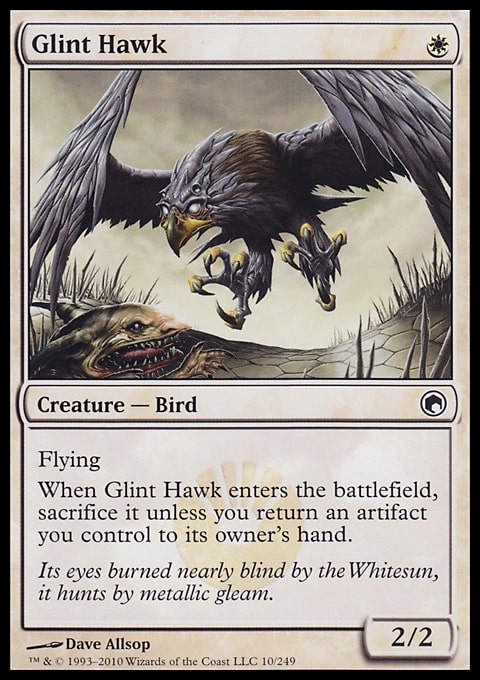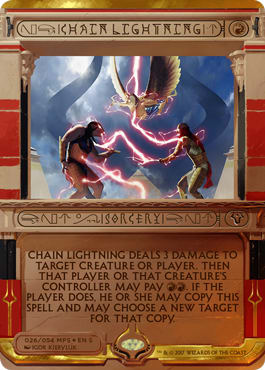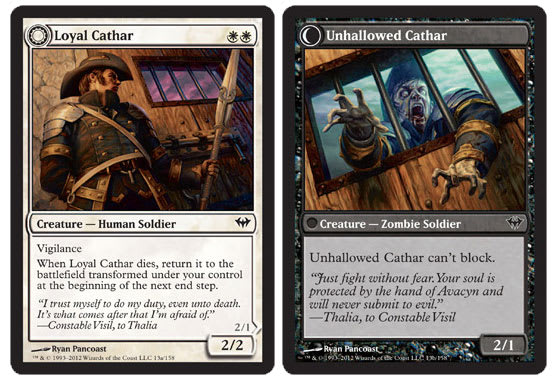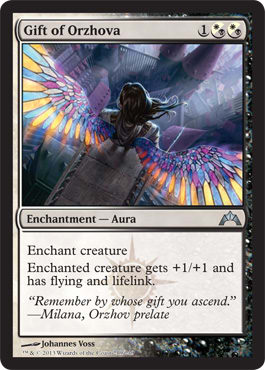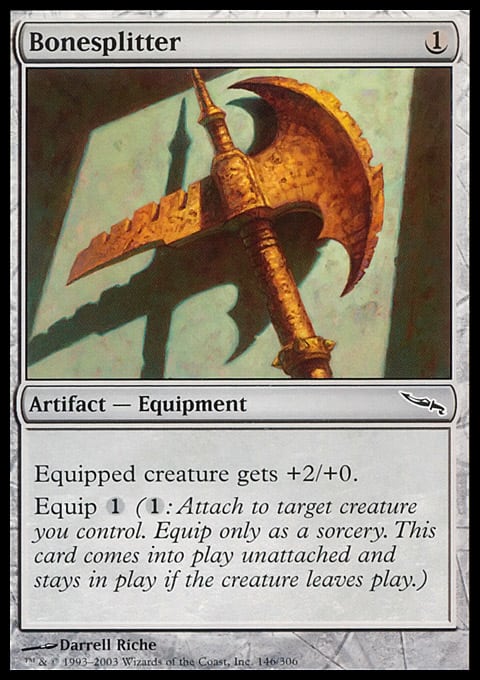The June 4th Pauper Challenge was won by Boros Monarch. The ![]()
![]() midrange deck is sitting pretty in the format, having placed at least one copy in the Top 8 of every challenge as of the writing of this article. It has the second most Top 8 finishes behind current “best deck in the format” Izzet Delver.
midrange deck is sitting pretty in the format, having placed at least one copy in the Top 8 of every challenge as of the writing of this article. It has the second most Top 8 finishes behind current “best deck in the format” Izzet Delver.
The deck is based around a commonly played Pauper engine — Glint Hawk and Kor Skyfisher with Prophetic Prism. Sometimes decks will pair Prism with Ichor Wellspring but Boros Monarch goes for Alchemist's Vial. The key element is that these Artifacts replace themselves upon entering the battlefield. Over the course of a game a single Prism can result in three new cards. As if that was not good enough these cards also turn on one of the best Red spells in the format: Galvanic Blast. Paired with Thraben Inspector the Hawk and Skyfisher engine can generate a steady, albeit expensive, flow of cards.
Rather than go wide, the Monarch version of this deck leans on Palace Sentinels to get even more looks. This is where the inclusion of Alchemist's Vial over Ichor Wellspring starts to make sense: it can turn off attackers that would normally steal the Monarch. Two copies of Prismatic Strands are split between the maindeck and sideboard to help prevent damage and, thus, preserve the crown. Prismatic Strands has been seeing more play as of late. The Instant is deceptively powerful considering how many aggressive Pauper decks are a single color. The ability to turn off an attack and leave a creature untapped to threaten a second activation is a significant deterrent. The fact this is also a counter to Electrickery, Crypt Rats, and Evincar's Justice does not hurt.
After turtling up and amassing resources, Boros Monarch can go on the offensive. Kor Skyfisher and Glint Hawk are serviceable attackers in the air and when backed up with Lightning Bolt and Galvanic Blast the game can end in short order. Two copies of Battle Screech contribute to the air force but without Rally the Peasants the Bird tokens lack the same potential damage output.
Boros Monarch ? Pauper | Lord_Beerus, Winner, June 4th Pauper Challenge
- Creatures (16)
- 4 Glint Hawk
- 4 Kor Skyfisher
- 4 Palace Sentinels
- 4 Thraben Inspector
- Instants (9)
- 1 Prismatic Strands
- 4 Galvanic Blast
- 4 Lightning Bolt
- Sorceries (3)
- 1 Firebolt
- 2 Battle Screech
- Enchantments (2)
- 2 Journey to Nowhere
- Artifacts (8)
- 4 Alchemist's Vial
- 4 Prophetic Prism
- Lands (22)
- 2 Mountain
- 2 Plains
- 1 Forgotten Cave
- 2 Secluded Steppe
- 3 Boros Garrison
- 3 Radiant Fountain
- 3 Wind-Scarred Crag
- 3 Ancient Den
- 3 Great Furnace
- Sideboard (15)
- 1 Circle of Protection Green
- 1 Prismatic Strands
- 2 Ancient Grudge
- 2 Electrickery
- 2 Lone Missionary
- 3 Gorilla Shaman
- 4 Pyroblast
Looking beyond the Top 8 for a moment, the story of the June 4th challenge was the emergence of Red Deck Wins. Also known as the Other Burning-Tree Emissary deck, Red Deck Wins (RDW) draws on the numerous two-power 1-drops as well as the color’s 2-drops with Haste. With a strong suite of burn and Goblin Heelcutter to keep the path open, the deck is capable of winning in the blink of an eye. Burning-Tree Emissary helps to enable some pretty gross openings as RDW has plenty of redundant 2-drops with a single Red in their mana cost. An opening of Goblin Cohort into Burning-Tree Emissary into Valley Dasher can pile on the damage, and that's before Goblin Heelcutter shows up to turn off any blocker that might deign to arrive.
The deck had two appearances in the Top 16: 9th and 15th. The higher placing list runs some less conventional cards including Sparksmith and Bonesplitter. However I want to focus in on the 15th place list.
Red Deck Wins ? Pauper | DoubleDrain, Top 16 June 4th Pauper Challenge
- Creatures (31)
- 1 Sparksmith
- 3 Goblin Heelcutter
- 3 Valley Dasher
- 4 Burning-Tree Emissary
- 4 Goblin Bushwhacker
- 4 Goblin Cohort
- 4 Jackal Familiar
- 4 Mogg Conscripts
- 4 Mudbrawler Cohort
- Instants (8)
- 2 Fireblast
- 2 Mutagenic Growth
- 4 Lightning Bolt
- Sorceries (3)
- 3 Chain Lightning
- Artifacts (1)
- 1 Bonesplitter
- Lands (17)
- 16 Mountain
- 1 Forgotten Cave
- Sideboard (15)
- 1 Flame Slash
- 2 Flaring Pain
- 3 Sparksmith
- 3 Electrickery
- 3 Gorilla Shaman
- 3 Pyroblast
Red Deck Wins ? Pauper | SquirtleTheaeonsTorn, Top 16 June 4th Pauper Challenge
- Creatures (31)
- 3 Goblin Heelcutter
- 4 Burning-Tree Emissary
- 4 Goblin Bushwhacker
- 4 Goblin Cohort
- 4 Jackal Familiar
- 4 Mogg Conscripts
- 4 Mudbrawler Cohort
- 4 Valley Dasher
- Instants (10)
- 2 Fireblast
- 4 Lightning Bolt
- 4 Mutagenic Growth
- Sorceries (2)
- 2 Reckless Abandon
- Lands (17)
- 17 Mountain
- Sideboard (15)
- 1 Flaring Pain
- 3 Electrickery
- 3 Flame Slash
- 4 Gorilla Shaman
- 4 Pyroblast
SquirtleTheaeonsTorn is a terror of the Pauper league. They have been running (and placing) with Red Deck Wins since the deck first became viable. Squirtle’s deck shaves some of the more controlling elements (Sparksmith and Chain Lightning) for two cards that increase damage output. Mutagenic Growth allows you to save key creatures from removal mid-combat and also tap out during an attack and still force in extra damage. Reckless Abandon is the Online version of Goblin Grenade except that any creature can be used as fodder.
Red Deck Wins made three total appearances in the June 4th Challenge, enough for 9.38% of the metagame. Using the Frank Karsten method of scoring (one point for a match win, a point deduced per match loss), the deck performed close to its volume with a 10% win share. RDW takes advantage of sorcery speed removal — things like Chainer's Edict and Journey to Nowhere. While these cards are not the most popular options, at the moment the latter one, as well as Flame Slash, have been showing up more often.
Where Stompy is better at going tall with its threats thanks to Rancor and Vines of Vastwood, Red Deck Wins excels at going wide. The abundance of cheap two-power creatures makes it easy to be attacking for four on turn two. Haste is an underrated ability and when backed up by Goblin Bushwhacker the deck is capable of winning from nowhere. Goblin Heelcutter’s Dash ability also works incredibly well with Goblin Cohort and Mogg Conscripts since Dash turns on the cast requirement.
As mentioned, I think Red Deck Wins is going to be a strong choice moving forward and in part that is due to a deck that came out of nowhere to place two in the Top 8: Mono-White Aggro. There were two distinct versions that made the elimination rounds but given that the archetype was 6.25% of the Top 32 but had a weighted volume of 8.89%, it warrants further examination.
Mono-White Aggro ? Pauper | vihespanhol, Top 8 June 4th Pauper Challenge
- Creatures (26)
- 1 Kor Sanctifiers
- 2 Aviary Mechanic
- 2 Field Surgeon
- 2 Gideon's Lawkeeper
- 2 Lone Missionary
- 2 Standard Bearer
- 3 Loyal Cathar
- 4 Kor Skyfisher
- 4 Squadron Hawk
- 4 Thraben Inspector
- Sorceries (7)
- 3 Battle Screech
- 4 Sunlance
- Enchantments (3)
- 3 Journey to Nowhere
- Artifacts (3)
- 3 Bonesplitter
- Lands (21)
- 16 Plains
- 1 Drifting Meadow
- 4 Secluded Steppe
- Sideboard (15)
- 1 Standard Bearer
- 1 Journey to Nowhere
- 2 Celestial Flare
- 2 Lone Missionary
- 3 Kor Sanctifiers
- 3 Dust to Dust
- 3 Prismatic Strands
Mono-White Aggro ? Pauper | seedy_k, Finalist June 4th Pauper Challenge
- Creatures (26)
- 1 Aviary Mechanic
- 1 Benevolent Bodyguard
- 4 Guardian of the Guildpact
- 4 Icatian Javelineers
- 4 Kor Skyfisher
- 4 Loyal Cathar
- 4 Squadron Hawk
- 4 Thraben Inspector
- Sorceries (3)
- 3 Sunlance
- Enchantments (6)
- 2 Gift of Orzhova
- 4 Journey to Nowhere
- Artifacts (4)
- 4 Bonesplitter
- Lands (21)
- 19 Plains
- 2 Secluded Steppe
- Sideboard (15)
- 1 Sunlance
- 1 Cenn's Enlistment
- 1 Crimson Acolyte
- 1 Fragmentize
- 1 Lapse of Certainty
- 1 Rune of Protection Black
- 2 Dust to Dust
- 2 Relic of Progenitus
- 2 Rune of Protection Red
- 3 Rune of Protection Green
Both of these decks run the duo of Kor Skyfisher-Thraben Inspector alongside the full suite of Squadron Hawks. These cards are vitally important to midrange aggressive White decks as they do a solid impression of card advantage. Loyal Cathar also works well with Skyfisher thanks to its ability to transform. Once dead, the singular card can be picked back up and recast as a 2/2 with Vigilance. When combined with Bonesplitter (another inclusion in both decks) the Cathar becomes a powerful threat on both offense and defense. Both seedy_k and vihespanhol wanted more copies of Skyfisher and opted to add Aviary Mechanic for additional copies of the effect.
The decks diverge in one major way: vihespanhol topped their curve with Battle Screech while seedy_k went with Guardian of the Guildpact. Battle Screech allowed the 8th place deck to go wide and leverage Bonesplitter as a way to pick off blockers and eventually punch through damage. The inclusion of the token producer also led vihespnahol to Field Surgeon — a card which allows every creature to protect itself from Electrickery. Having this maindeck defense also made it easier for the deck to run two copies of Standard Bearer in the main. Surgeon and Bearer can turn off Red based removal provided enough creatures are untapped. That being said the deck does run more undersized creatures and it fell to the eventual champion in the quarterfinals.
Guardian of the Guildpact represents a different endgame. Rather than going wide, seedy_k decided they wanted to establish a hard to handle threat. Guardian has long been a staple in Pauper for just this reason — very few heavily played cards can take it off the table. Despite being vulnerable to Chainer's Edict a midrange White deck is the perfect home for Guardian since it can flood the board with cards like Squadron Hawk and Loyal Cathar, making it more likely for the 2/3 to survive.
The problem with White decks is that since the explosion of Kor Skyfisher decks with Galvanic Blast, they have problems keeping up. The decks with only Plains may run more actual threats but lacks the reach that burn spells provide. In the end, the deck with access to Red would often be able to close out games quickly. This is where Gift of Orzhova shines. It can bolster a life total in short order and when placed on Guardian of the Guildpact is makes for a quick clock. If the Guardian can carry a Bonesplitter then things spiral out of control quickly.
There is something funny about the reemergence of this strategy. In the earliest days of sanctioned Pauper, a Guardian of the Guildpact enchanted with Armadillo Cloak was a regular sight. The ancestor of the current Slippery Bogle Hexproof deck, ![]()
![]() just ran good creatures backed up with the Guardian-Cloak endgame. Eventually Rancor made its way online and this deck fell by the wayside in favor of Stompy, but the fact remains — Guardian of the Guildpact with Lifelink is good.
just ran good creatures backed up with the Guardian-Cloak endgame. Eventually Rancor made its way online and this deck fell by the wayside in favor of Stompy, but the fact remains — Guardian of the Guildpact with Lifelink is good.
The strategy seemed to work. In the quarterfinals seedy_k dispatched Izzet Delver before taking out a Rally the Peasants-Battle Screech Boros deck in the semis. Both of these decks lean on Red for removal and reach and I do not doubt that the copy of Crimson Acolyte in the sideboard prove valuable. Eventually, the deck fell in the finals, but Guardian of the Guildpact proved itself to be a force once again.
It does not take much to convince me to play Mono-White Aggro and so when I saw the results I decided to give my old standby a shot. I was putting together seedy_k’s list in Magic Online I realized it was very similar to a build I had run before Peregrine Drake hit the format. I decided to modify the finalist’s build with my own and ended up taking it into the league. I ended up cutting down to three copies of Guardian of the Guildpact as I felt that four on 21 lands was too great a risk. I also cut the single Aviary Mechanic and Benevolent Bodyguard to make room for two copies Razor Golem and a single Angelic Purge as a piece of catchall removal. I opted to run Snow-Covered Plains simply for aesthetic purposes and took the deck into the league on stream.
The results were better than I had hoped for.
Mono-White Aggro ? Pauper | Alex Ullman, 5-0 Pauper League
- Creatures (25)
- 2 Razor Golem
- 3 Guardian of the Guildpact
- 4 Icatian Javelineers
- 4 Kor Skyfisher
- 4 Loyal Cathar
- 4 Squadron Hawk
- 4 Thraben Inspector
- Sorceries (4)
- 1 Angelic Purge
- 3 Sunlance
- Enchantments (6)
- 2 Gift of Orzhova
- 4 Journey to Nowhere
- Artifacts (4)
- 4 Bonesplitter
- Lands (21)
- 1 Secluded Steppe
- 20 Snow-Covered Plains
- Sideboard (15)
- 1 Cenn's Enlistment
- 1 Divine Offering
- 1 Sunlance
- 1 Unmake
- 2 Celestial Flare
- 2 Dust to Dust
- 2 Kor Sanctifiers
- 2 Prismatic Strands
- 3 Standard Bearer
The deck never does anything broken. Instead it plays a fair game but does it exceedingly well thanks to Bonesplitter. The Mirrodin Equipment enhances every threat and, like Rancor, can make for a quick clock. Unlike Rancor it can be passed back and forth with ease, meaning that extra mana can be spent to turn a creature into an offensive threat and another into an imposing blocker. Guardian of the Guildpact provides inevitability and a form of reach. Once a game progresses long enough and with a life total within striking distance, a Guardian will seal the deal.
Guardian of the Guildpact decks appear to be a strong choice for the current metagame. Even with the presence of Burning-Tree Emissary as a regularly played multicolored card. The metagame has placed an emphasis on efficient instant speed removal which is almost universally going to slough off Guardian.
I think Guardian is better than the other two potential curve toppers at the moment for this reason. Battle Screech is a great card but every deck is prepared for it (or should be). I often find myself siding out Squadron Hawk against Stompy to render their Scattershot Archer useless. Trading a turn to make four Birds only to get undone by Electrickery is a massive blow. Renegade Freighter suffers by dying easily to Lightning Bolt. In order for Vehicles to be good, Flame Slash needs to outperform Lightning Bolt, and currently that is not the case. Investing two creatures in an attack that will fail is not a way to win games of Pauper. Razor Golem is vulnerable twice over as a creature and an artifact. I found that running two as a supplement to Guardian made sense since it does have Vigilance and could apply pressure while keeping my life total safe. The fact that it cannot tap to enable Flashback on Prismatic Strands does come up.
When midrange White decks are viable, Pauper is healthy. These decks will never bowl you over with an unanswerable draw. Their ability to win through advancing their board state means that Pauper is currently supporting decks at both ends of the spectrum of speed. White decks stand at the fulcrum of the scales and, as such, help to center the format. They may not be this powerful forever, but for the time being I am going to enjoy sending my Guardian to the skies.













